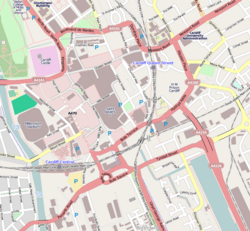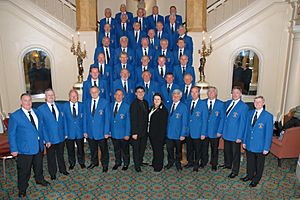Cardiff Arms Park facts for kids
|
Rugby ground
|
|||||||||||||||||||||||||||
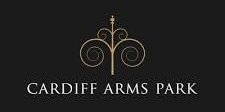 |
|||||||||||||||||||||||||||
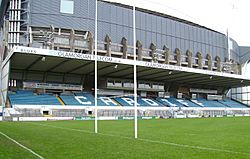
Cardiff Arms Park in the foreground and the Millennium Stadium in the background
|
|||||||||||||||||||||||||||
| Location | Cardiff, Wales | ||||||||||||||||||||||||||
|---|---|---|---|---|---|---|---|---|---|---|---|---|---|---|---|---|---|---|---|---|---|---|---|---|---|---|---|
|
|||||||||||||||||||||||||||
|
National Stadium
Welsh National Rugby Ground |
|||||||||||||||||||||||||||||||||
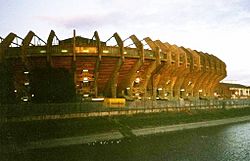 The West Stand of the National Stadium |
|||||||||||||||||||||||||||||||||
|
|||||||||||||||||||||||||||||||||
|
Cricket ground
|
|||||||||||||||||||||||||
 Aerial view of the cricket ground |
|||||||||||||||||||||||||
|
|||||||||||||||||||||||||
Cardiff Arms Park (Welsh: Parc yr Arfau Caerdydd), also known as The Arms Park, is situated in the centre of Cardiff, Wales. It is primarily known as a rugby union stadium, but it also has a bowling green. The Arms Park was host to the British Empire and Commonwealth Games in 1958, and hosted four games in the 1991 Rugby World Cup, including the third-place play-off. The Arms Park also hosted the inaugural Heineken Cup Final of 1995–96 and the following year in 1996–97.
The history of the rugby ground begins with the first stands appearing for spectators in the ground in 1881–1882. Originally the Arms Park had a cricket ground to the north and a rugby union stadium to the south. By 1969, the cricket ground had been demolished to make way for the present day rugby ground to the north and a second rugby stadium to the south, called the National Stadium. The National Stadium, which was used by Wales national rugby union team, was officially opened on 7 April 1984, however in 1997 it was demolished to make way for the Millennium Stadium in 1999, which hosted the 1999 Rugby World Cup and became the national stadium of Wales. The rugby ground has remained the home of the semi-professional Cardiff RFC yet the professional Cardiff Blues regional rugby union team moved to the Cardiff City Stadium in 2009, but returned three years later.
The site is owned by Cardiff Athletic Club and has been host to many sports, apart from rugby union and cricket; they include athletics, association football, greyhound racing, tennis, British baseball and boxing. The site also has a bowling green to the north of the rugby ground, which is used by Cardiff Athletic Bowls Club, which is the bowls section of the Cardiff Athletic Club. The National Stadium also hosted many music concerts including Michael Jackson, Dire Straits, David Bowie, Bon Jovi, The Rolling Stones and U2.
Contents
History
Early history of the site
The Cardiff Arms Park site was originally called the Great Park, a swampy meadow behind the Cardiff Arms Hotel. The hotel was built by Sir Thomas Morgan, during the reign of Charles I. Cardiff Arms Park was named after this hotel. From 1803, the Cardiff Arms Hotel and the Park had become the property of the Bute family. The Arms Park soon became a popular place for sporting events, and by 1848, Cardiff Cricket Club was using the site for its cricket matches. However, by 1878, Cardiff Arms Hotel had been demolished.
The 3rd Marquess of Bute stipulated that the ground could only be used for "recreational purposes". At that time Cardiff Arms Park had a cricket ground to the north and a rugby union ground to the south. 1881–2 saw the first stands for spectators; they held 300 spectators and cost £50. The architect was Archibald Leitch, famous for designing Ibrox Stadium and Old Trafford, among others. In 1890, new standing areas were constructed along the entire length of the ground, with additional stands erected in 1896.
Music concerts
Major music concerts were also held at the National Stadium from 1987 until 1996, they included Tina Turner, U2, Michael Jackson, The Rolling Stones, Dire Straits, Bon Jovi and R.E.M. The last music concert was held on 14 July 1996. Jehovah's Witnesses held their annual conventions at the National Stadium.
Singing tradition
The National Stadium was known primarily as the venue for massed voices singing such hymns as "Cwm Rhondda", "Calon Lân", "Men of Harlech" and "Hen Wlad Fy Nhadau" ("Land of my Fathers" – the national anthem of Wales). The legendary atmosphere including singing of the crowd was said to be worth at least a try or a goal to the home nation. This tradition of singing has now passed on to the Millennium Stadium.
The Arms Park has its own choir, called the Cardiff Arms Park Male Choir. It was formed in 1966 as the Cardiff Athletic Club Male Voice Choir, and today performs internationally with a schedule of concerts and tours. In 2000, the choir changed their name to become the Cardiff Arms Park Male Choir.
Images for kids
See also
 In Spanish: Cardiff Arms Park para niños
In Spanish: Cardiff Arms Park para niños


